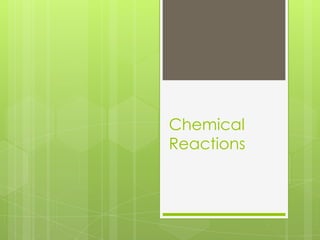Chemical reactions
•Télécharger en tant que PPTX, PDF•
2 j'aime•1,269 vues
Signaler
Partager
Signaler
Partager

Recommandé
Contenu connexe
En vedette
En vedette (15)
Similaire à Chemical reactions
Similaire à Chemical reactions (20)
Unit b matter and chemical change notes(chemical reactions)

Unit b matter and chemical change notes(chemical reactions)
Plus de MrsKendall
Plus de MrsKendall (17)
Isotopes, Lewis Dot Diagrams and Predicting Reactions

Isotopes, Lewis Dot Diagrams and Predicting Reactions
Dernier
https://app.box.com/s/x7vf0j7xaxl2hlczxm3ny497y4yto33i80 ĐỀ THI THỬ TUYỂN SINH TIẾNG ANH VÀO 10 SỞ GD – ĐT THÀNH PHỐ HỒ CHÍ MINH NĂ...

80 ĐỀ THI THỬ TUYỂN SINH TIẾNG ANH VÀO 10 SỞ GD – ĐT THÀNH PHỐ HỒ CHÍ MINH NĂ...Nguyen Thanh Tu Collection
Dernier (20)
UGC NET Paper 1 Mathematical Reasoning & Aptitude.pdf

UGC NET Paper 1 Mathematical Reasoning & Aptitude.pdf
Exploring_the_Narrative_Style_of_Amitav_Ghoshs_Gun_Island.pptx

Exploring_the_Narrative_Style_of_Amitav_Ghoshs_Gun_Island.pptx
ICT role in 21st century education and it's challenges.

ICT role in 21st century education and it's challenges.
On National Teacher Day, meet the 2024-25 Kenan Fellows

On National Teacher Day, meet the 2024-25 Kenan Fellows
HMCS Max Bernays Pre-Deployment Brief (May 2024).pptx

HMCS Max Bernays Pre-Deployment Brief (May 2024).pptx
General Principles of Intellectual Property: Concepts of Intellectual Proper...

General Principles of Intellectual Property: Concepts of Intellectual Proper...
Fostering Friendships - Enhancing Social Bonds in the Classroom

Fostering Friendships - Enhancing Social Bonds in the Classroom
Interdisciplinary_Insights_Data_Collection_Methods.pptx

Interdisciplinary_Insights_Data_Collection_Methods.pptx
80 ĐỀ THI THỬ TUYỂN SINH TIẾNG ANH VÀO 10 SỞ GD – ĐT THÀNH PHỐ HỒ CHÍ MINH NĂ...

80 ĐỀ THI THỬ TUYỂN SINH TIẾNG ANH VÀO 10 SỞ GD – ĐT THÀNH PHỐ HỒ CHÍ MINH NĂ...
Chemical reactions
- 2. Recap of Chem vs. Phys Propeties Chemical Properties- The characteristic of a substance that describes its ability to change into a new substance Example: Burning of Magnesium into MgO Physical Properties- A characteristic of a substance that can be observed without changing the substance into a new substance Example: Ice Melting, Cutting a piece of paper
- 3. Recap of Chem vs. Phys Changes Chemical changes- a chemical reaction which results in one or more new substances being formed Example: Burning a log in a fireplace Physical changes- a change that alters the form or appearance of something, but does not create a new substance Example: Melting metal and reshaping into a ring
- 4. Bonding and Chemical Reactions In order for a chemical reaction to have taken place, bonds must have been broken and re-created!! Atoms rearrange to create something totally new. Bonds can change from one form to another; covalently bonded atoms can rearrange to create ionic bonded atoms (like with the Mg lab)
- 5. Evidence that a Reaction has Occured: Precipitate forms (solid is formed out of liquids w/o freezing) Heat is released Light is released Energy change (exothermic or endothermic) Gas is formed (usually in the form of bubbles) Color change (unexplained, weird) Rapid temp change (hand warmers, instant ice pack)
- 6. Balancing Equations Reactant + Reactant Product + Product In a chemical equation, reactants go on the left, products are always on the right.
- 7. Conservation of Matter In 1774, Antoine Lavoisier introduced us to the idea of the conservation of Matter. Conservation of Matter tells us that matter is neither created nor destroyed. This means that the total mass of the reactants must equal the total mass of products. This also means that the number of atoms stays the same, they are just rearranged when the bonds are broken and re-created.
- 8. Open vs. Closed Remember the difference between open and closed systems for a chemical reaction? Open System- the chemical reaction may call upon the elements around it (like taking Oxygen from the air) Closed System- the chemical reaction may only use what it started with and cannot add anything new during the change.
- 9. Factors of a Chem Reaction Activation energy- the amount of energy needed to start a chemical reaction (ALL chemical reactions require activation energy) Surface Area, Concentration, Temperature and presence of catalysts and/or inhibitors will have a huge effect on how quickly a chemical reaction will occur.